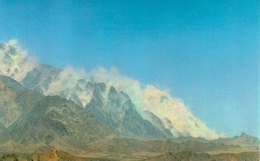Pakistan's Nuclear Programme

We know that Israel and
South Africa have full nuclear
capability. The Christian, Jewish and Hindu
civilizations
have this capability. The communist powers
also possess
it. Only the Islamic civilization was
without it, but that
position was about to change.
On Feb. 7, 1992 Pakistani Foreign Minister Shahryrar Khan stated in an
interview with the Washington Post that Pakistan had the components to
assemble
one or more nuclear weapons. This goes farther than statements
from any other
"non-weapon state" in admitting to the existence of a nuclear
arsenal.
Pakistan had previously admitted to having fabricated pits for fission
weapons.
In July 1993 General (retired) Mirza Aslam Beg, former army chief
of staff,
claimed that Pakistan had tested a nuclear device. Since no information
about an
actual nuclear explosion has come to light, this presumably refers
to a
hydronuclear (zero-yield) test of a design.
The Pakistani nuclear weapons program began in great secrecy the 1970s after
the Indian test of a nuclear device in 1974. Serious work commenced in 1976 with
the establishment of the Engineering Research Laboratories (ERL).
The source of the intelligence gathered at URENCO, and the driving force
behind its development into an industrial scale process in Pakistan, is a
Pakistani metallurgist named Dr. Abdul Qader Khan, who can be fairly called the
father of the Pakistani nuclear program.

Dr. Abdul Qader Khan in 1993
A. Q. Khan was employed from 1972 to 1975 by Ultra-Centrifuge Nederland (UCN)
the Dutch partner in the URENCO consortium where he worked with two early
centrifuge designs, the CNOR and SNOR machines. In 1974 UCN asked Khan to
translate classified design documents for two advanced German machines, the G-1
and G-2. He left then Europe, before his espionage was detected, and assumed
technical leadership of the program at ERL. Due to his efforts, the slow
recognition of the program by western intelligence, and the weak export controls
at the time, Pakistan made rapid progress in developing U-235 production
capability.
In recognition of Khan's contributions the ERL was renamed the A.Q. Khan
Research Laboratories by President Zia ul-Haq in 1981.
The uranium enrichment facility is the Kahuta gas centrifuge plant near
Islamabad. This facility began operating in the early 1980s, but suffered
serious start up problems. Dr. Khan announced that Kahuta was producing low
enriched uranium in 1984. US intelligence believes that uranium enrichment
exceeded 5% in 1985, and that production of highly enriched uranium was achieved
in 1986. At that time Pakistan had reportedly manufactured 14000 centrifuges,
but had only 1000 operating. By 1991 about 3000 machines were operating
according to US intelligence. This implies a production capacity of 45-100 kg
U-235/year depending on the tails concentration and production efficiency,
enough for 3-7 implosion weapons. Shahryar Khan has said that the cost of Kahuta
was relatively modest, less than $150 million.
SIPRI (Stockholm International Peace Research Institute) estimates that
Pakistan had acquired 120-220 Kg of enriched uranium by the end of 1991 (8-15
weapons).
On the testimony of General Beg it would appear that this has
probably progressed to the stage of hydronuclear tests of a complete weapon
design. Pakistan probably acquired the ability to build a nuclear weapon soon in
1986, or soon after.
Pakistan has built a second enrichment plant at Golra, 6 miles from
Islamabad. It is expected to be even larger than Kahuta, with more advanced
centrifuges. It may not yet have begun production though due to difficulty in
obtaining the necessary parts now. In March 1996 the New York Times reported
that last year China had sold Pakistan 5000 ring magnets suitable for use in gas
centrifuges.
Pakistan is developing weapons-related nuclear technology in other areas as
well. It has a pilot plutonium reprocessing plant called "New Labs" at
the Pinstech complex near Rawalpindi. Currently Pakistan's known reactors are
all safeguarded by the IAEA, and thus unavailable for use in a weapons program.
Pakistan is known to have been developing a "swimming pool" reactor in
the late 80s using domestically produced enriched uranium fuel, which may
already be in operation. Pakistan is also manufacturing reactor-grade graphite,
presumably for a natural uranium plutonium production reactor. It currently
possesses one power reactor with an output of 137 MW electrical. A 300 MWe
pressurized water reactor for electricity which is under construction by the
China National Nuclear Corporation at Chashma.
It has been reported recently that a 50 MWe "multi purpose"
heavy-water reactor, entirely constructed by Pakistani engineers, has been
completed near Khusab, in Punjab.It is said to be used for isotope production
for export and for doping silica for use in solar energy applications. This has
since been dismissed as "inaccurate and baseless" by Pakistani
sources, but a "small experimental reactor" at Khusab.
First Pakistan's Nuclear tests
